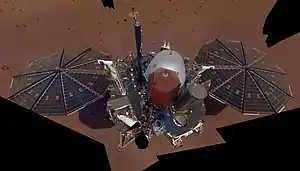2018 LF16
2018 LF16 is a small near-Earth asteroid of the Amor group, first observed by astronomers with the Pan-STARRS survey at Haleakala Observatory on 14 June 2018. Based on limited observations, early estimates of its size of 213 m (699 ft) would make it extremely destructive if it collided with Earth, but predicted orbits make a collision unlikely.
 The best inclined orbit is currently completely outside Earth's orbit, with markers every 30 days of motion. | |
| Discovery [1] | |
|---|---|
| Discovered by | Pan-STARRS 1 |
| Discovery site | Haleakala Obs. |
| Discovery date | 14 June 2018 |
| Designations | |
| 2018 LF16 | |
| NEO · Amor [1][2] | |
| Orbital characteristics [2] | |
| Epoch 15 June 2018 (JD 2458284.5) | |
| Uncertainty parameter 9 | |
| Observation arc | 1.8 days[3] |
| Aphelion | 2.6756 AU |
| Perihelion | 1.1432 AU |
| 1.9094 AU | |
| Eccentricity | 0.4013 |
| 2.64 yr (964 d) | |
| 313.01° | |
| 0° 22m 24.96s / day | |
| Inclination | 15.473° |
| 166.30° | |
| 188.78° | |
| Earth MOID | 0.138 AU (53.9 LD) |
| Physical characteristics | |
Mean diameter | 213 m[3] 280 m[4] |
| 20.3[1] 20.5[2][4] 21.0[3] | |
In November 2018, news article headlines exaggerated[5] claims of 62 potentially dangerous Earth-orbit crossings in the next century but also reported NASA calculations indicating there is only a 1 in 30,000,000 chance of impact.[6] Additionally, 2018 LF16 is rated at 0 on the Torino Scale, meaning that the chance of impact is so low as to effectively be zero. The observation arc extends only 1.8 days,[3] leaving large uncertainties in its predicted motion,[7][8] causing 2018 LF16 to be considered a lost asteroid.[9]
Its current best orbit leaves it entirely outside of Earth's orbit, never coming closer than 0.13 AU to Earth (MOID).
It is placed 9492nd on near-Earth asteroid Tisserand parameters list.[10]
References
- "2018 LF16". Minor Planet Center. Retrieved 7 January 2019.
- "JPL Small-Body Database Browser: (2018 LF16)" (2018-06-16 last obs.). Jet Propulsion Laboratory. Retrieved 7 January 2019.
- "Sentry: Earth Impact Monitoring - Object Details 2018 LF16". Jet Propulsion Laboratory. Retrieved 6 August 2020.
- "ESA space situational awareness 2018LF16". European Space Agency. Retrieved 6 August 2020.
- Wehner, Mike (26 November 2018). "No, asteroid 2018 LF16 probably isn't going to hit the Earth". Boy Genius Report.
- Kettley, Sebastian (25 November 2018). "NASA asteroid WARNING: 700-foot-wide space rock on 62 RISK trajectories with Earth by 2023". Express.co.uk. Retrieved 26 November 2018.
- "MPC Ephemerides for Visible Risk-Listed Objects". www.hohmanntransfer.com. Retrieved 26 November 2018.
- Chamberlin, Alan. "JPL Small-Body Database Browser". ssd.jpl.nasa.gov. Retrieved 26 November 2018.
- "NEODyS-2 - Near Earth Objects - Dynamic Site - Risk List". SpaceDys. Retrieved 6 August 2020.
- "Near-Earth Asteroid Tisserand Parameters". Jet Propulsion Laboratory. Retrieved 6 August 2020.
External links
- 2018 LF16 at NeoDyS-2, Near Earth Objects—Dynamic Site
- Ephemeris · Obs prediction · Orbital info · MOID · Proper elements · Obs info · Close · Physical info · NEOCC
- 2018 LF16 at ESA–space situational awareness
- 2018 LF16 at the JPL Small-Body Database


